Pantas’ Cabinet of Mathematical Wonders: Images and the History of Mathematics
Overview
Images of historical instruments for measuring and computing, of people who contributed to mathematics, and of written mathematical works from the past, such as books and notes, can and should be used to enrich mathematics teaching and learning. We offer ideas and resources for engaging students using images, especially those of historical objects, manuscripts, and texts, in teaching mathematics.
This article resulted from a workshop of the same name given by the author at the 7th European Summer University on History and Epistemology in Mathematics Education, July 14–18, 2014, Aarhus University, Copenhagen, Denmark. A version of this article will appear in the proceedings of that conference.
Nota de las editoras: Para acceder a una versión en español de este artículo, haga clic aquí.
Pantas’ Cabinet of Mathematical Wonders: Images and the History of Mathematics – Introduction
Introduction
A few years ago while visiting the British Museum, I was attracted to a display case containing cuneiform tablets from the Old Babylonian Period (1800–1600 BCE). One tablet in particular attracted my attention; it was a palmsized oval with several columns of characters. Consulting the information supplied about this tablet, I learned that it was a sexagesimal multiplication table. Here was evidence of a young student, probably a scribe in training, learning his (n.b. Babylonian scribes were males) multiplication facts thousands of years ago. This realization impressed upon me the continuity of mathematics and its required learning tasks over a period of 4000 years. But what would impress me even more deeply was the imprint of a human finger that accompanied the numerals and was preserved in the hard baked clay surface. It jarred me both emotionally and conceptually. This mark served as testimony to the human involvement with mathematics; it reinforced the fact that a person, an individual, did this mathematics. Despite further years of study and research on the history of mathematics, the impact of this image—affirming the need to acknowledge and attempt to understand the persistent human involvement with mathematics—has remained with me. An old adage says that “One picture [or image] is worth a thousand words.” I certainly believe this.
For many years, one of my major professional ventures has been to convince mathematics teachers, at all levels, to incorporate the history of mathematics, the record of human involvement, into their teaching. I feel such an endeavor helps to humanize the subject; that is, to remove its aura of mystery and better reveal mathematics as a natural, human activity. Usually, teachers appreciate the implications of this association, but then the practical task of just how to incorporate history into mathematics teaching arises. Teaching time is valuable and examination standards must be met. If historical insights are to be provided they must be effective and minimally intrusive. Working with teachers, we have explored several appropriate strategies, including:
- the use of occasional anecdotes or brief stories from the history of mathematics,
- employing historically-related mathematical learning tasks in small group settings [Swetz 1994],
- and the classroom assignment of actual historical word problems [Swetz 2012].
Generally, such attempts, if diligently undertaken, have produced favorable results. Still, the expenditure of “valuable” classroom time remains a deep concern for teachers. One effective solution to this issue is the use of visually-centered displays: images and posters that pertain to relevant historical personages and achievements. Images can be used as part of the classroom instruction—illustrating, enriching and reinforcing the specific concept being discussed—or as a passive learning aid—displayed to attract student attention, arouse curiosity, and perhaps prompt further investigation. Extra-credit reports can be centered about an image; for example (see Figure 1), “Here is a copy of two pages from a nearly 400-year-old English geometry book. What do you recognize? What unusual things do you see?”
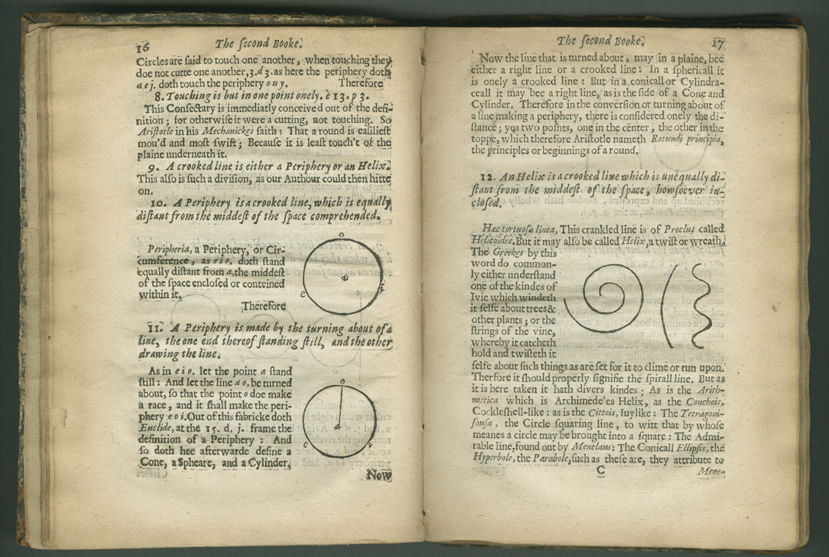
Figure 1. Pages from The Way to Geometry, a 1636 English translation of a text written in 1596 by Peter Ramus. (Image presented courtesy of the Rare Book and Manuscript Collection at Columbia University. You may use this image in your classroom; all other uses require permission from the Columbia University Libraries.)
Another source for pages similar to the pair above is Robert Recorde’s 1551 The Pathway to Knowledge, Containing the First Principles of Geometrie, which is available in facsimile [1551/1974].
Pantas’ Cabinet of Mathematical Wonders: Images and the History of Mathematics – To Know How to See
Let me give two examples of instances when the use of historical images resulted in fruitful discussions and prompted further learning. During the 2004 History and Pedagogy of Mathematics Conference in Uppsala, Sweden, Leo Rogers gave a talk, “Robert Recorde, John Dee, Thomas Digges, and the ‘Mathematicall Artes’ in Renaissance England” [Rogers 2004], in which he employed several illustrations. One simple image, from Robert Recorde’s Pathway to Knowledge [1551] excited the audience: “Where did you get that? How can I get a copy?” (See Figure 2.)
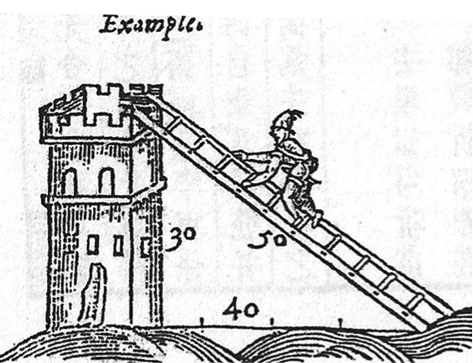
Figure 2. Image from Robert Recorde’s 1551 Pathway to Knowledge,
illustrating an application of the Pythagorean Theorem.
The situation depicted is elementary: it shows a man ascending a ladder to reach the top of a tower. The geometry reveals a right triangle—actually a 3-4-5 right triangle—and the viewer is asked to determine the length of the ladder when the height of the tower is given as 30 feet and the foot of the ladder is 40 feet away from the tower. What is the pedagogical / psychological appeal here?
- The ladder against a wall problem is familiar to almost all young algebra and geometry students.
- The illustration is from the 16th century: “They were doing the same problems as us almost five hundred years ago!”
- The Pythagorean theorem is being demonstrated: Given the lengths of the two legs of the triangle, the viewer can find the length of the hypotenuse. (Or, given the lengths of the hypotenuse and one leg, the viewer can find the length of the remaining leg.)
- A 3-4-5 right triangle is involved.
- The illustration appeals to the imagination of a young viewer: A castle is being stormed.
At a talk I gave in the U.S. at a National Council of Teachers of Mathematics (NCTM) Conference (Indianapolis, 1994), I briefly discussed and illustrated the galley method of division by using an image from a 1604 manuscript presented to King James I of England as a gift [Waymouth 1604]. (See Figure 3.)
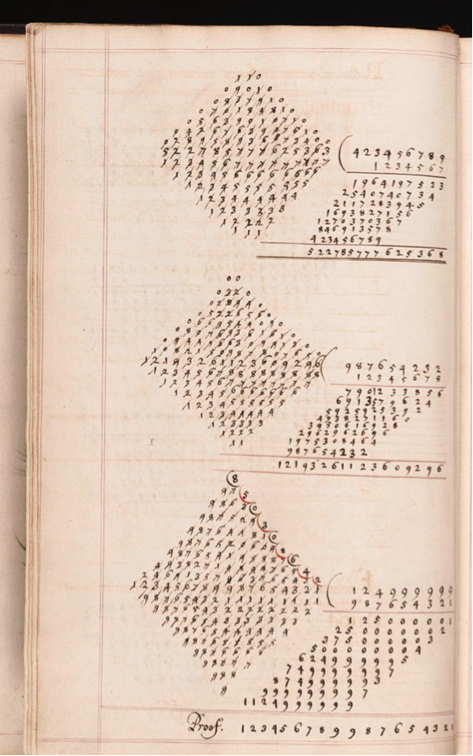
Figure 3. "Galley division" demonstrated in the handwritten and illustrated manuscript, The Jewell of Artes, prepared by George Waymouth, who presented it as a gift to King James I of England in 1604. (Image provided courtesy of the Beinecke Rare Book and Manuscript Library, Yale University. You may use this image in your classroom; all other uses require permission from the Beinecke Library.)
After this talk, the student aides, all secondary school students, solicited me to show them this diagram again and to explain it in detail, elaborating on just how the operation of division was being carried out. First, they were visually attracted to the number configuration: a large rhombus (or diamond) of numbers. They soon became conceptually involved: if this is a division exercise, “How was the process undertaken?” I explained the algorithm, line by line, pointing out the significance of the crossed-out or “scratched-out” terms, and noted that, due to its appearance, the technique was sometimes referred to as “scratch division.” In this discussion, I also interjected the fact that at this time in history, there were several division algorithms in use and this one, more popularly known as “galley division,” was the most frequently performed. I left my audience with the provocative comment that I believe this algorithm to be more mathematically efficient than the one we have actually adapted for school teaching, the “downward” or “Italian division” method. I hoped some of the students would investigate and attempt to substantiate my claim.
In selecting images for instructional purposes, two requirements should be fulfilled:
- The material should appeal to the viewer; that is, be visually or conceptually attractive or intriguing. It should seduce the viewer “to want to find out more.”
- It should have purpose and power by pertaining to the mathematical situation, topic, or concept you wish to promote and clarify.

Figure 4. Basket from northern Thailand.
For example, view the object in Figure 4. Can you see any mathematics? Ask a companion to perform the same task and compare what each of you see. Hopefully, each of you has perceived some similar images: a circle, trapezoids, hexagons, etc. (Do you see the star?) You would probably eventually query, “What is this object? Where did it come from?” If so, I have set you up to pursue the topic of ethnomathematics. The object in question is a container for sticky rice as served during a meal in northern Thailand. The tribal people who made the basket never had formal schooling or studied geometry, and yet they exhibited knowledge of the geometric shapes you have discovered and were certainly concerned with the concept of volume—in this case, the volume of a circular cylinder of rice.
Pantas’ Cabinet of Mathematical Wonders: Images and the History of Mathematics – Selecting Images – Ancient Artifacts
Appropriate computer searches reveal an abundance of images of instruments for measuring and computing; of people who contributed to mathematics; and of actual mathematical works, such as books and notes, that can be used to enrich mathematics teaching and learning [Kidwell 2021]. If known by name, they can be sought out; for example, images of the Ishango Tally Bone, the oldest existing human mathematics artifact, are available online, including as a “mathematical treasure” here in MAA Convergence. (See Figure 5.)
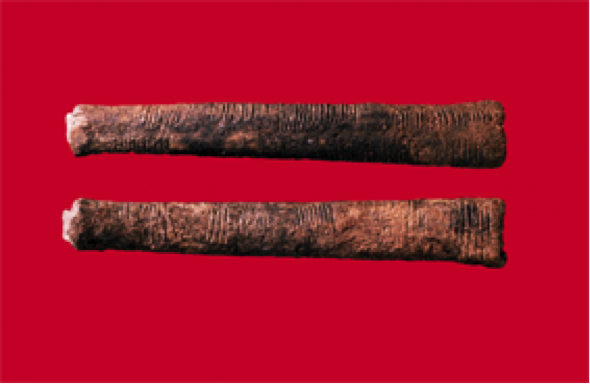
Figure 5. The Ishango tally bone is believed to be 20,000 to 25,000 years old. (Image presented courtesy of the Museum of Natural Sciences, Brussels, Belgium. You may use this image in your classroom; all other uses require permission from the Museum of Natural Sciences, Royal Belgian Institute of Natural Sciences.)
The age of the Ishango bone, 20,000–25,000 years, testifies to the long human involvement with mathematics and the need to record mathematical data. Conjectures about its function prepare the audience for a discussion of numeration in general. This can lead to the topic of tally sticks, and the rather interesting and amusing story of the British Exchequer’s Office 1826 fire. Due to the office’s disposal of centuries of accumulated tally sticks by burning, the House of Lords was set afire and burned down.
A very effective and information-laden image which has appeared in several books on the history of mathematics is Yale Babylonian Cuneiform 7289 (YBC 7289), a cuneiform tablet from the Old Babylonian period (circa 1900–1600 BCE). (See Figure 6.)
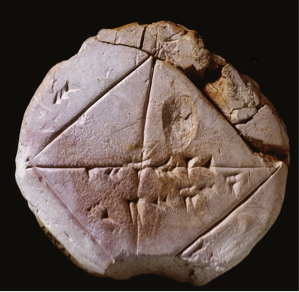 |
 |
Figure 6. The clay "palm tablet" shown above, left, would fit in the hand of an ancient Mesopotamian scribe. A transcription and a translation are shown at right. (Image at left presented courtesy of the Yale Babylonian Collection. You may use this image in your classroom; all other uses require permission from the Yale Babylonian Collection. Images at right appear on p. 27 of the book by Asger Aaboe [1998/1964] and are reproduced here courtesy of the Mathematical Association of America.)
First, one notes the physical size of the clay tablet. It fits into a man’s hand, and indeed it was a palm tablet, held conveniently in the palm of one hand while the scribe, using his other hand, wrote on it. Modern students visualize cuneiform clay tables as being quite large—perhaps they are influenced by the stylized biblical illustrations of Moses holding the tablets of the Judeo-Christian Ten Commandments. But the most striking feature to the novice viewer is that the diagram clearly shows a square with its diagonals. Yes, the ancient Babylonians drew accurate geometric diagrams in clay as part of their mathematical discussions. Once, when I offered this illustration in an article for publication, I was challenged by the journal’s editor, who suspected I had drawn the diagram myself and was falsely attributing its origins to the Babylonians. Even very sophisticated people do not appreciate the fact that ancient mathematicians drew geometric diagrams to assist in problem solving.
Next, a deciphering of the cuneiform inscription reveals two numbers in sexagesimal notation: what we know as \(\sqrt 2\) and \(\sqrt 2\times 30,\) where \(30\) is the specified length of the side of the square. (See Figure 6b.) At this point in the inspection, two implications emerge:
- that at this early period before the rise of Greece and the Pythagoreans, the Babylonians possessed what we generally know as “the Pythagorean Theorem,” and
- that these ancient people could extract the square root of a number to several decimal places of accuracy.
Another obvious question then arises: “How did they do it?” Furthermore, if one looks closely at the image, one can see the “telltale” human fingerprint!
In addition to the book by Aaboe, images and discussion of this tablet appear in textbooks, including Burton [1997, p. 77] and Hodgkin [2005, p. 25].
Pantas’ Cabinet of Mathematical Wonders: Images and the History of Mathematics – Selecting Images – Early Books
Finding appropriate images for instruction may require a more formal search and research on the part of the instructor. In an instance where I desire to talk on the subject of linear measure and would like to use actual examples of societally devised units of measure (Figure 7), taken from the German humanist Peter Apian’s Cosmographia [1524], would provide a learning inducement.
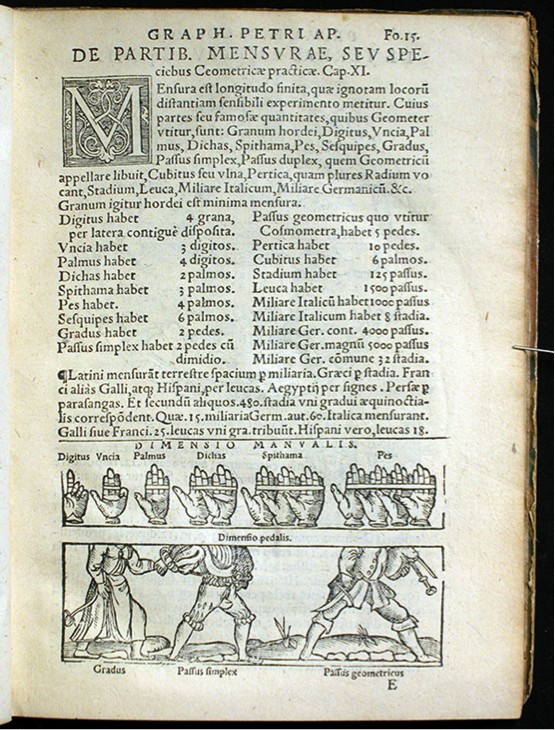
Figure 7. Definitions of various measurements in Peter Apian’s 1524 Cosmographia. (Image presented courtesy of History of Science Collections, University of Oklahoma Libraries. You may use this image in your classroom; all other uses require permission from the University of Oklahoma Libraries.)
It illustrates and demonstrates the use of fingers and feet to designate distance measures of the 16th century, ones not usually known or recognized by the modern viewer: one foot or pes equals four palmos (singular palmus) or palms of the hand; a leuca, or league, the distance a person can walk in one hour, equals 1500 passus or paces; and an Italian military mile is 1000 paces, whereas a German military mile comprises 4000 paces.
Young children enjoy duplicating finger postures as illustrated in Luca Pacioli’s Summa [1494] and popular in the Middle Ages to designate numbers.
Another image that I have employed with great success in working with secondary school students is a page from the Swiss mathematics teacher Johann Alexander’s algebra book, Synopsis Algebraica [1693]. (See Figure 8.)

Figure 8. Problems about triangles from Johann Alexander’s Synopsis Algebraica. (Image presented courtesy of Archives and Special Collections, Dickinson College, Carlisle, Pennsylvania. You may use this image in your classroom; all other uses require permission from Archives and Special Collections, Waidner-Spahr Library, Dickinson College.)
In the history of mathematics texts, this book is rather unique; it is a text/workbook where instruction is provided on one page and the facing page is left blank for notes and computations. It is the first such book of this kind that I know of. On page 60, three geometric situations are given requiring algebraic solutions. Although the book, including its exercises, is written in Latin, an astute student of today can understand the problems. A student from the 17th century offered a solution for problem 35. Is it correct? My audience finds a mistake: The equation \(aa+cc=bb+2bx\) should read \(aa-cc=bb+2bx\) and the solution \(x=\frac{aa-bb-cc}{2b}\). Given the values for \(a,\) \(b,\) and \(c,\) this yields \(x=5\) and \(y=12,\) which might have been guessed at the start. Then I ask the audience to solve the remaining problems; they are thrilled to be solving “400-year-old problems.”
Throughout history, millions of such diagrams and illustrations have been devised to promote mathematical learning and understanding. They can be resurrected to serve immediate teaching needs and, further, they bear the added feature of an historical dimension, which increases their attraction for the modern viewing audience.
One last example of an image-inspired encounter: A calculus student in a colleague’s class was directed to an image of Isaac Newton’s The Method of Fluxions and Infinite Series with its Application to the Geometry of Curved Lines [1736]. She was enthralled to see the actual book that introduced calculus, albeit with fluxions, to her historical peers and instigated the mathematical field of analysis. Interpreting the frontispiece (see Figure 9) reveals an interesting story. The scene shows two country gentlemen hunting birds. They judge the flight of the birds and allow a lead in their aim; that is, they judge the velocity correctly. Just below and to the left of the hunters is a group of classical philosophers debating the action. The literal translation for the Latin inscription pertaining to the hunters is: “Velocities perceived by the senses are measurable by the senses.” The lower Classical Greek reads, “What was common then is the same now. [Things don’t change].” John Colson, who translated Newton's work (from Latin to English) and edited the book, was mindful of the controversies surrounding the calculus, particularly George Berkeley’s charges in The Analyst (1734).
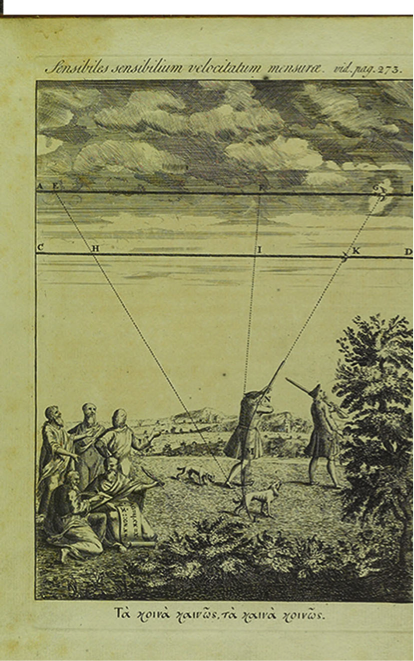
Figure 9. Frontispiece of Isaac Newton’s 1736 The Method of Fluxions and Infinite Series with its Application to the Geometry of Curved Lines. (Image presented courtesy of Lehigh University. You may use this image in your classroom; all other uses require permission from the Special Collections staff, Linderman Library, Lehigh University.)
But my colleague's calculus student was more interested in another aspect of the book. Reading the title page (see Figure 10), she was prompted to investigate the circumstances resulting in the appearance of this text.
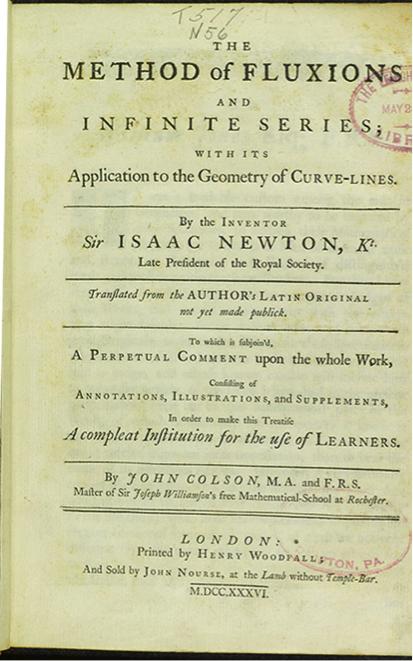
Figure 10. Title page of Isaac Newton’s 1736 The Method of Fluxions and Infinite Series with its Application to the Geometry of Curved Lines. (Image presented courtesy of Lehigh University. You may use this image in your classroom; all other uses require permission from the Special Collections staff, Linderman Library, Lehigh University.)
The book was attributed to Newton as the author but was actually composed by John Colson after Newton’s death. “Who was Mr. Colson and what was his association with Isaac Newton?” “Why didn’t Newton himself publish the book while he was alive?” Such questions and the resulting revelations supplied by their answers add much to the understanding of how mathematics is developed, transmitted, and refined.
Of course, before introducing an historical image to a class, the instructor herself or himself must be historically knowledgeable about the significance of the item in question.
Pantas’ Cabinet of Mathematical Wonders: Images and the History of Mathematics – Obtaining Images – Resources
As the previous discussion has revealed, there are many available resources from which to seek historical mathematical images for instructional purposes, and I have suggested some techniques for their classroom introduction. We all have our personal collection of mathematics texts and reference books that can supply us with images. Library searches, especially among large university holdings, also prove fruitful; however, computer searches of existing digital collections similarly provide many visual treasures. A listing of some available sites appears below. In such search efforts, one must be mindful to comply with all legal and/or cost requirements attached to items.
However, the Mathematical Association of America, MAA, has compiled an archive of historical images specifically intended for instructional purposes that is available to all mathematics teachers and researchers free of cost. It is found online in the Association’s electronic journal Convergence as the feature “Mathematical Treasures.” The majority of images discussed here, together with over a thousand others, are available for use from “Mathematical Treasures.” I sincerely hope that many readers of this article will avail themselves of this wonderful resource.
Resources for Historical Images
The Mathematical Association of America > Convergence > Mathematical Treasures
United States Library of Congress > Digital Collections
World Digital Library > Mathematics
British Library > Digital Collection > Mathematics
Yale University > Beinecke Library > Digital Collections > Mathematics
University of Pennsylvania > Rare Books > Mathematics
University of Indiana > Lilly Library > Rare Books > Mathematics
University of Oklahoma > History of Science > Mathematics
Oxford University > Museum of the History of Science
Cuneiform Inscriptions
Friberg, Jöran. 2007. A Remarkable Collection of Babylonian Mathematical Texts: Manuscripts in the Schøyen Collection of Cuneiform Texts I (Sources and Studies in the History of Mathematics and Physical Sciences). New York: Springer.
Pantas’ Cabinet of Mathematical Wonders: Images and the History of Mathematics – References
References
Aaboe, Asger. 1964. Episodes from the Early History of Mathematics. Washington, D.C.: MAA, 1998 (originally published in 1964). See especially pp. 25–27.
Alexander, Johann. 1693. Synopsis Algebraica. London: Benjamin Motte.
Apian, Peter. 1524. Cosmographia. Antwerp.
Burton, David. 1997. The History of Mathematics: An Introduction. New York: McGraw-Hill.
Hodgkin, Luke. 2005. A History of Mathematics: From Mesopotamia to Modernity. Oxford: Oxford University Press.
Katz, Victor, and Frank Swetz. 2004–2020. Mathematical Treasures from the Smith and Plimpton Collections at Columbia University. MAA Convergence.
Kidwell, Peggy Aldrich. 2021. Keys to Mathematical Treasure Chests. MAA Convergence 18.
Newton, Isaac. 1736. The Method of Fluxions and Infinite Series with its Application to the Geometry of Curved Lines. London: Henry Woodfall.
Pacioli, Luca. 1494. Summa de Arithmetica. Venice: Paganini.
Record[e], Robert. 1551. The Pathway to Knowledge, Containing the First Principles of Geometrie. London; facsimile published 1974, Amsterdam: Walter J. Johnson, Inc.
Rogers, Leo. 2004. Robert Recorde, John Dee, Thomas Digges, and the ‘Mathematicall Artes’ in Renaissance England. In Proceedings HPM2004 & ESU4, 122–131. Uppsala, Sweden.
Swetz, Frank. 1994. Learning Activities from the History of Mathematics. Portland, ME: J. Weston Walch.
Swetz, Frank. 2012. Mathematical Expeditions: Exploring Word Problems across the Ages. Baltimore: Johns Hopkins University Press.
Waymouth, George. 1604. The Jewell of Artes. London; handwritten and illustrated manuscript presented to James I.